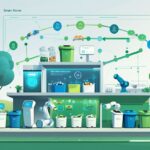A Berry Big Problem
Australia is facing a surprising shortage: blueberries. Supermarket giants Coles and Woolworths have both reported empty shelves where the juicy, antioxidant-rich fruit once sat. This isn’t just a mild inconvenience for smoothie lovers—it’s part of a broader issue affecting global food supply chains.
Unpredictable weather, supply chain disruptions, labor shortages, and climate change have combined to squeeze one of the country’s favorite fruits out of reach. But could Artificial Intelligence (AI) be the unlikely hero that rescues the blueberry industry and ensures your breakfast bowl never goes berry-less again?
What’s Causing the Blueberry Shortage?
Several key factors are contributing to the current scarcity:
- Extreme weather events — including heavy rains and droughts — have reduced yields.
- Labor shortages have made it difficult to pick and process berries during peak harvest times.
- Supply chain delays are making transport slower and less reliable.
- Increased demand both domestically and internationally for fresh, healthy produce.
These overlapping challenges create a perfect storm. And while traditional agricultural solutions can help, they may not be fast or efficient enough. That’s where AI steps in.
How AI Can Revolutionize Berry Farming
AI technologies are already reshaping farming worldwide. Here’s how they can address the blueberry crisis:
1. Precision Agriculture
AI-powered drones and satellites can monitor crop health in real time, detecting disease or drought stress early. For blueberries, this means farmers can apply water, fertilizer, or pest control exactly where it’s needed—boosting yield and saving resources.
2. Climate-Resilient Crop Modeling
AI models can analyze years of weather, soil, and plant data to help farmers choose the most resilient blueberry varieties and planting times. This mitigates the risks of poor harvests due to unexpected weather changes.
3. Automated Harvesting
Robotic systems guided by computer vision and machine learning can pick blueberries efficiently, reducing reliance on seasonal labor. This ensures more consistent harvesting, even during labor shortages.
4. Supply Chain Optimization
AI can predict market demand, monitor transport routes, and flag disruptions before they impact delivery. Retailers like Coles and Woolworths could use these insights to source berries from alternative regions or adjust pricing dynamically to reduce waste.
5. Smart Greenhouses
Controlled environments powered by AI can grow blueberries year-round, independent of outdoor weather. These vertical farms or smart greenhouses adjust temperature, light, and humidity automatically for optimal growth.
The Global Perspective
Australia isn’t the only country facing such shortages. Globally, AI is already being used to grow strawberries in Tokyo skyscrapers, optimize apple orchards in the US, and fight banana diseases in Africa. Blueberries are the next frontier—and AI has the tools to make production more resilient and predictable.
Can AI Really Fix the Crisis?
While AI can’t make blueberries magically appear overnight, it can provide long-term, scalable solutions to agricultural volatility. With investment and collaboration between tech firms, farmers, and retailers, AI can help stabilize supply, reduce waste, and bring fresh fruit back to supermarket shelves—even in challenging times.
The blueberry shortage may be a wake-up call. As climate change and global demand continue to stress our food systems, embracing smart technologies is not just an advantage—it’s a necessity.





